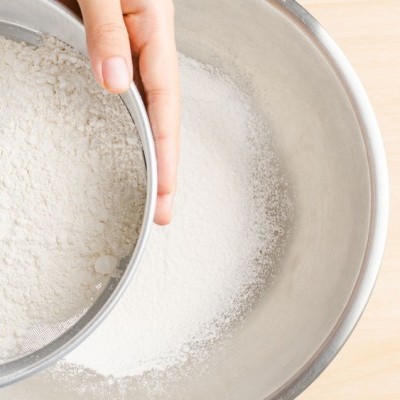
Heat Treated Flour
What is Heat Treated Flour?
Heat treated flour has been heated to an optimal temperature range of 210°F to 230°F for 60 minutes.1 It can:
- Extend shelf life
- Increase volume of cakes
- Create a fine even grain in finished goods.6
Heat treated flour is characterized by its ability to absorb moisture and the inability of its protein content to form gluten when the flour is hydrated. It is most commonly used with high ratio baked goods.
Origin
The purpose of the heat treatment is to reduce the build-up of pathogens in the flour during its shelf-life. Many consumers do not realize flour is a raw ingredient. An outbreak of E. coli which spanned 24 states infecting 64 people was linked to consumption of raw dough.6 Prior to treating flour using heat, preservation, and transportation of flour was difficult since it would go bad quickly.
The process for heat treating flour, first patented in 1970, is a safer alternative to chlorination and irradiation.2 The ability of heat treated flour to absorb moisture is a valued component in food because it adds softness to flour, making it desirable to eat.2
Nutrition
Research on heat treated flour has shown the potential for better digestibility of protein content than in raw flour.3 There is increased palatability as a result of the heating process.2 Flour is a rich source of vitamins, proteins, fiber and other complex carbohydrates that are necessary for the daily functioning of the body.
Commercial Production
The commercial production of the heat treated flour occurs through a series of steps.5
- Flour is thermally dehydrated until the moisture content is reduced.
- The heat treated flour is cooled at room temperature
- The dehydrated flour is heated again, and the moisture content is retained.
By the end of these heating steps, the proteins are denatured and moisture absorption, due to starch gelatinization ability, is increased. 7
Application
Heat treated flour works well with high ratio baked goods such as cakes, cookies and muffins. Gelatinization of starch granules occurs during the heat treatment of flour allowing starch granules to absorb more water.7 Starch granules swell with water adding viscosity to batter and stabilization to the baking process. Baked goods produced with heat treated flour have improved texture, height and volume.
Due to the weakened protein structure, breads and other yeasted products do not rise or develop as well when using heat treated flour.
FDA Regulation
At this time there is no FDA Regulation regarding heat treated flour. However, the “FDA warns against eating raw dough products made with any brand of flour or baking mix before cooking. Consumers should always practice safe food handling and preparation measures when handling flour.” 6
References
- Neill, G., Ala’a H. Al-Muhtaseb, and T.R.A. Magee. “Optimisation of time/temperature treatment, for heat treated soft wheat flour.” Journal of Food Engineering 113.3 (2012): 422-426.
- Doe, Cedric Allen, and Judith Russo. Flour Treatment Process. Lyons & Co Ltd J, assignee. Patent US3490917 A. 20 Jan. 1970. Print.
- Marston, Kathryn G. Effect of Sorghum Flour Treated with Ozone and Heat On the Quality of Gluten-Free Bread and Cake. Manhattan, Kan.: Kansas State University, 2009. Print.
- Valdramidis, Vasilis P and Jan F. van Impe. Progress On Quantitative Approaches of Thermal Food Processing. Hauppauge, N.Y.: Nova Science Publishers, 2012. Print.
- RUSSO, JUDITH V., and C. A. DOE. “Heat treatment of flour as an alternative to chlorination.” International Journal of Food Science & Technology 5.4 (1970).
- “FDA Investigated Multistate Outbreak of Shiga Toxin-producing E. Coli Infections Linked to Flour.” FDA Investigated Multistate Outbreak of Shiga Toxin-producing E. Coli Infections Linked to Flour. FDA, 29 Sept. 2016. http://www.fda.gov/food/recallsoutbreaksemergencies/outbreaks/ucm504192.htm
- Magee, T. R. A., and G. Neill. “Effects of heat treatment on protein denaturation and starch gelatinisation in wheat flour.”International Conference on Engineering and Food, Athens, Greece. 2011.

